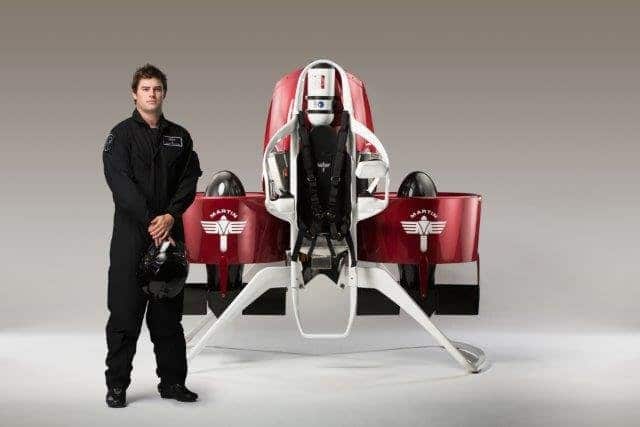Aerospace
Get ready for Future .. !! Now Personal jet machine is on market .

[huge_it_slider id=”5″]
The Martin Aircraft Company, based in New Zealand, is now taking deposits for the consumer version of its single-person jet pack, which has been in development for more than 30 years. Over the years, the company has successfully flown several prototypes, but it has continued to refine the design in search of easy handling, stable flight characteristics, safety, and reliability.
The Martin Jetpack can fly for up to 30 minutes at about 35 mph and cruise at altitudes of up to 3,000 feet, thanks to a proprietary two-stroke V-4 engine that the company developed to deliver the high power-to-weight ratio and steadiness that the design demands. Fly-by-wire assisted-stability controls and an integrated ballistic parachute enhance the jet pack’s ease of use and safety.
Martin is also developing a jet-pack training simulator, which it plans to put on the market in 2015, and an unpiloted aerial vehicle, which will be ready in 2016. Late in 2016, the company also plans to offer a Jetpack Experience, which will provide a simulator ride for the public overseen by an instructor on the ground with the capability to override the controls if necessary. A jet-pack aerial demonstration team is scheduled to start flying at air shows next summer. The Martin Jetpack is expected to sell for $200,000, with deliveries starting by 2017.
Contact here
Address:
Martin Aircraft Company
39 Ballarat Way, Wigram
Christchurch 8042
New Zealand
Telephone: +64 3 377 8584
Fax: +64 3 982 4614
Website – http://www.martinjetpack.com
[issuupress]
Source : Martinjet
[issuupress viewer=”mini” titlebar=”false” vmode=”” ctitle=”Pick a PDF file to read” height=”240″ bgcolor=”FFFFFF”]

Aerospace
Boeing Transfers Rocket Stage to NASA, Paving Way for Human Moon Mission

Boeing has achieved a significant milestone by providing NASA with the second core stage of the Space Launch System (SLS) rocket.
This crucial component, crafted at NASA’s Michoud Assembly Facility (MAF), is set to propel the Artemis II crew into lunar orbit, marking humanity’s return to deep space after a 50-year hiatus.
The monumental Boeing-built rocket stage, the largest element of the Artemis II mission, will embark on a journey aboard the Pegasus barge, traveling 900 miles to NASA’s Kennedy Space Center.
Comparison of two legendary aircraft B777x vs B747 aircraft:Click here
Upon arrival, it will be meticulously integrated with other essential Artemis II components, including the upper stage, solid rocket boosters, and NASA’s Orion spacecraft within the iconic Vehicle Assembly Building. This intricate integration process is a vital step toward the eagerly anticipated Artemis II launch, slated for 2025.
“Boeing-built products helped land humankind on the moon in 1969, and we’re proud to continue that legacy through the Artemis generation,” remarked Dave Dutcher, vice president and program manager for Boeing’s SLS program. “Together, with NASA and our industry partners and suppliers, we are building the world’s most capable rocket and paving the way to deep space through America’s rocket factory in New Orleans.”
NASA, Lockheed Martin Reveal X-59 Quiet Supersonic Aircraft:Click here
The delivery of Core Stage 2 marks a significant achievement in the evolution of the SLS rocket. Towering over 200 feet and powered by four RS-25 engines, this core stage, coupled with two solid-fueled booster rockets, will generate a staggering 8.8 million pounds of thrust. This immense power is crucial to launching Artemis II and future missions into the vast expanse of space.
The SLS rocket stands unparalleled in its capability to transport both crew and substantial cargo to the moon and beyond in a single launch. Its extraordinary capacity will facilitate the delivery of human-rated spacecraft, habitats, and scientific missions to destinations including the moon and Mars, ushering in a new era of space exploration.
-

 Travel1 week ago
Travel1 week agoAir India to Expand US Operations with Three New Routes After a Decade
-

 Travel2 weeks ago
Travel2 weeks agoWhy We Should Avoid These Stamps in a Passport
-

 Airlines1 month ago
Airlines1 month agoInvestigations Reveal Fake Chinese Titanium in Boeing and Airbus Jets
-

 Tech4 weeks ago
Tech4 weeks agoChina’s CATL Plans 1,800-Mile Electric Plane Launch by 2027
-

 Airport3 days ago
Airport3 days agoTop 10 Largest Airports in the World by Size
-

 Aerospace4 weeks ago
Aerospace4 weeks agoChina’s Fighter Jets Turn Wings into Autonomous Drones
-

 Airlines4 days ago
Airlines4 days agoAir India Rolls Out A350s for Delhi-New York JFK and Newark Routes
-

 Defence3 weeks ago
Defence3 weeks agoBoeing Enhances Chinook with New Engines and Block II Upgrades at $96 Million







